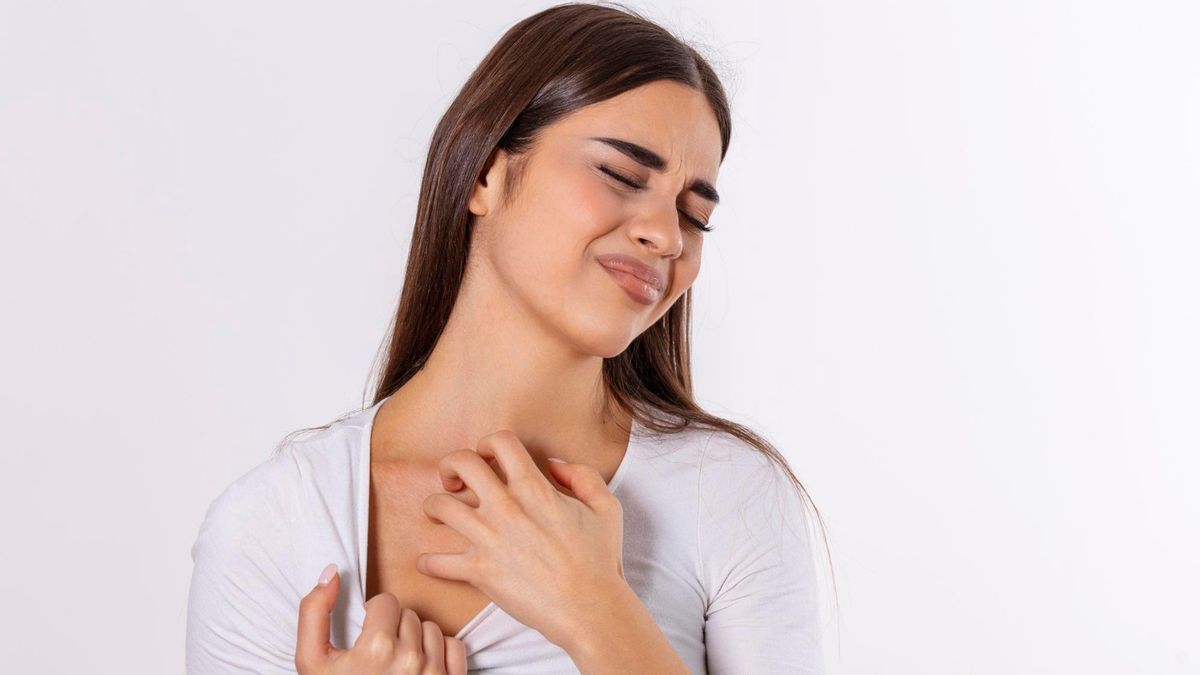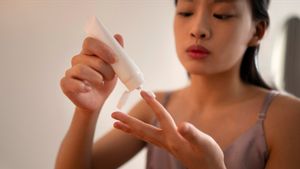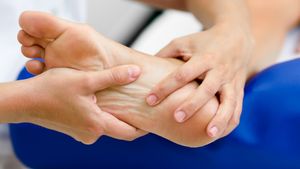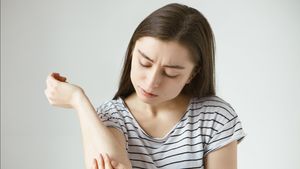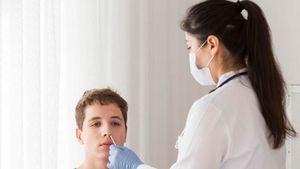YOGYAKARTA Dermatitis is also called eczema, for which general symptoms include itching, scaly skin, inflamed rashes, fuses that secrete the liquid, and ketombe on the skin. It is important to note, dermatitis or eczema are not transmitted from one person to another. To better recognize the factors that cause each type of dermatitis, symptoms, and how to treat, check the explanation.
The cause of a person experiencing stationary dermatitis is due to varises caused by the condition of blood circulation piling up in the lower leg. So the symptoms can be seen when the skin thickens and changes color on the ankle or dry bone. In the area it feels itchy, even the wound opens due to swelling and then breaks.
Launching the National Eczema Association, Sunday, July 28, stationary dermatitis is also referred to as gravitational dermatitis, venous eczema, and venous stationary dermatitis. This occurs due to poor blood circulation in the lower leg. In effect, venous insufficiency makes blood flow back to the heart weaken so that liquids, water are collected, and swollen feet. Causes of venous insufficiency, among others, due to aging, heart disease, kidney disease.
In addition to swelling, brown-orange spots appear. This spot is formed when there is swelling and suppresses the capillary. When experiencing symptoms of stationary dermatitis, it must be treated immediately. Because if it is not treated immediately, it can be injured or experience venison. Stasis dermatitis treatment needs to be done by overcoming the root of the problem. Usually done based on a doctor's diagnosis. If it is to treat temporary symptoms, by using compression to reduce swelling, raising your leg above the heart every two hours, avoiding foods that contain salt, taking vitamin C supplements, and taking itching pills.
Contact dermatitis occurs when in contact with substances that trigger allergic reactions. Symptoms are the same as other types of eczema but contact dermatitis is not dropped in family history and is not associated with other allergic conditions.
There are two types of contact dermatitis, namely irritants and allergies. Irritant contact dermatitis is experienced 80 percent of all who have contact dermatitis. Dermatitis contact irritan does not involve allergic reactions by the immune system. But caused damage to skin cells due to circumstellar exposure. Such as detergents, soaps, bleaching, jewelry containing nickel, to solvents. Dermatitis of allergen contact, occurs after being exposed to allergen then the body produces a strong inflammation reaction. Symptoms of itching are itching in one to two days.
Dematis kontak menyebabkan berbagai masalah kulit, termasuk kulit itching, berak, atau bersisik, serta lesi atau vesicel di area yang terkena. Reaksi kulit yang lebih parah parahnya termasuk hypersensitivitas terhadap muhari, peningkatan risiko terbakar matahari, dan irritasi akibat izin surya. Lepuh yang mengeluarkan cair juga dapat terjadi pada kasus yang lebih parah.
Contact dermatitis is usually treated with deristency of dermatologist prescriptions. Such as hydrocortison and steroids treating symptoms disrupting the dermatitis of irritan and antihistamine contacts for dermatitis of allergic contacts or other treatments according to a doctor's recommendation. Condensant dermatitis is one of the types of dermatitis that is lost by itself. But that doesn't mean letting symptoms without treating them.
Atopic dermatitis is most common. The condition can be experienced repeatedly, coming and going throughout the year or throughout age. In people exposed to atopic dermatitis, the immune system is irregular and too active. Because this triggers inflammation that damages the skin layer, makes the skin dry and prone to itching, rash and appears purple in brownish or grayish.
Research shows that people with atopic dermatitis have gene mutations, called filaggrin, which is responsible for the protective layer on the top layer of the skin made of protein. This is why many atopic dermatitis sufferers have very dry skin and are susceptible to infection. Atopic dermatitis, usually started in childhood or the first six months of baby life. In some cases, the condition of children who experience atopic dermatitis subsides as they grow up. However, there are also conditions that are recurrence to adulthood.
Rare to know, atopic dermatitis occurs in conjunction with other allergic conditions, namely asthma and ringitis allergies orPAir allergies. Usually this condition is derived in family history. How to treat atopic dermatitis, namely by avoiding triggers, maintaining regular bathing routines and using moisturizers to protect and strengthen skin layers, rest and quality sleep, eating healthy foods, and managing stress. Other treatments are based on a doctor's prescription, including topical, topical nonsteroid, and biological corticosteroids.
Neurodermatitis attacks 12 percent of the world's population. When it experiences great itching and crosses it hard. Without treatment, neurodermatics can rarely disappear. Because stretching one or two itching dots means continuously irritates the ends of the skin's nerves to exacerbate itching and garukan.
"In some ways, scratch is fun, not because you want to do it, but because it gives relief and satisfaction. This helps explain why scratch can be a habit that often occurs without realizing it, and why this itching cycle is difficult to stop," explains Dr. Gil Yosipovitch, professor and director of the Miami Itch Center at the Department of Dermatology and Skin Surgery Dr. Phillip Frost, Faculty of Medicine Miller University of Miami, Florida.
Neurodermatitis is most common in adults between the ages of 30 and 50 and is more common in women and people with atopic dermatitis and dermatitis. This condition is rarely diagnosed in children, although some people with atopic dermatitis also experience neurodermatics. People with psoriasis and anxiety disorders increase the risk of neurodermatics.
How to treat neurodermatics, which is treating itching. Doctors may use corticosteroids, other topical drugs such as salicylic acid containers, occlusive treatments. Certain patients may require counseling or cognitive behavioral therapy aimed at addressing anxiety that contributes to itching cycles.
Oriental dermatitis, symptoms appear small lumps negligibly around the mouth. Launching Mayo Clinic, this type of dermatitis can also affect the skin around the mouth, namely around the nose, cheeks, and eyes. The exact cause of periodic dermatitis is unknown, but the corticosteroid drugs contained in several nasal sprays, nasal sprays, and creams may play a role.
SEE ALSO:
Seboroic dermatitis is a common form of eczema that attacks the skin of the head, although it can also attack other parts of the body. Dermatitis of this type, rarely causes severe damage to the body. It's just that it is characterized by itching, rashes, and a ketombe scales appear on the skin's surface.
Seboroik dermatitis is usually caused by a combination of genetic factors and the environment. The trigger is the inflammatory reaction to the excess yeast Malassezia which is sometimes called pitysporum. Certain medical conditions can increase the risk of a person suffering from seboronic dermatitis, including psoriasis, HIV, acne, rosacea, Parkinson's disease, epilepsy, alcoholism, depression, eating disorders, and recovery from stroke or heart attacks.
Non-communicable seboroic dermatitis is treated depending on the severity of the case. At the simplest level, people with seboroic dermatitis only need to replace the shampoo and then the symptoms disappear without treatment. If seboroik dermatitis lasts more than two weeks, it is important to consult a health care provider so that they get a doctor's recommendation to treat them.
The English, Chinese, Japanese, Arabic, and French versions are automatically generated by the AI. So there may still be inaccuracies in translating, please always see Indonesian as our main language. (system supported by DigitalSiber.id)
